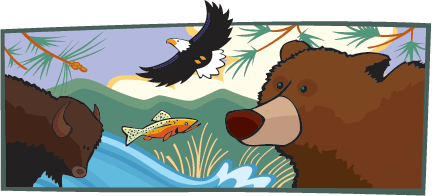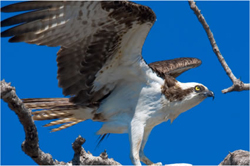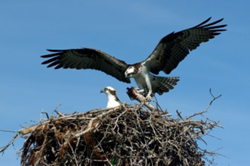Montana's wild wildlife!
Updated: August 10, 2020
From the arid bad-lands of Makoshika State park to the snowy, white peaks of Glacier National Park, animals and plants of many species flourish here.

Taking Wing:
Montana's Osprey

Hunting on the wing, an osprey appears to glide effortlessly over the water. These large raptors have narrow wings, which they bend when soaring and scanning for fish beneath the surface. Ospreys have dark brown feathers on their back and a white belly. The head is also white, with a brown eye stripe extending from the eye to the shoulders. The undersides of the wings are white except for dark wrist patches and brown-barred flight feathers. Though smaller than an eagle, ospreys are still big, ranging in length from 21 to 24 inches with wingspans of 54 to 72 inches.
An osprey may nest in any location that is near a body of water and provides safety and an abundance of fish. Osprey nests are generally found close to a body of water such as a lake, reservoir, or river. Even during migration, ospreys stay close to water, often following river valleys when they depart from Montana by October for wintering areas in Central and South America.
Since ospreys are so particular about living close to the water, it’s not surprising that they are fish-eating specialists. Nearly their entire diet consists of fish; it is extremely rare that they will eat anything else. On the Upper Missouri River, salmon are commonly the catch of the day. Barbed footpads on the soles of an osprey’s feet and long, sharp, curved claws help it grip slippery fish so its lunch doesn’t get away. In addition, ospreys have dense, oily plumage and nasal valves that prevent water from entering the nostrils when it dives to catch a fish.
Unlike eagles, which usually build nests in live trees below the tree canopy, sspreys prefer to build their nests at the tops of stout dead tree trucks. In the absence of a natural spot in which to build, however, an osprey will make its nest on manmade structures such as telephone poles and nest platforms designed especially for it. Such platforms have become an important tool in reestablishing ospreys in areas where they had disappeared.

Ospreys arrive in Montana in March and April to build their nests. Male and female ospreys share the work of collecting materials for the nest, but the female does most of the arranging of materials at the nest. Ospreys typically construct their nests with sticks and line them with softer materials such grasses or cardboard.
In April or May the ospreys lay their eggs, and the average clutch consists of three. The eggs do not hatch all at once; instead, the first chick hatches out up to five days before the last one. The older chick often bullies its younger siblings and snatches up the majority of food brought to the nest by the parents. Bald eagles, great horned owls, and raccoons are known predators of osprey nestlings, but the speckled appearance of osprey chicks camouflages them in the nest. If they get enough food and remain safe from predators, the young leave the nest in July and August when they are about two months old.
With the introduction and widespread use of the pesticide DDT osprey populations in many areas declined sharply in 1950s and ‘60s. DDT was banned in the US in 1972, and osprey populations have since then recovered. Today, ospreys may be a valuable indicator species for monitoring the long-term health of large rivers such as the Missouri because of their fish-based diet and sensitivity to contaminants. Ospreys are also such beautiful, impressive animals that they are beneficial to many areas because they draw tourists—AND the Missoula Osprey Minor League Baseball team is even named for this swift, graceful bird! (Learn more about Montana's animals>>)
You can listen to an osprey’s loud whistled call here.
Updated: August 10, 2020





